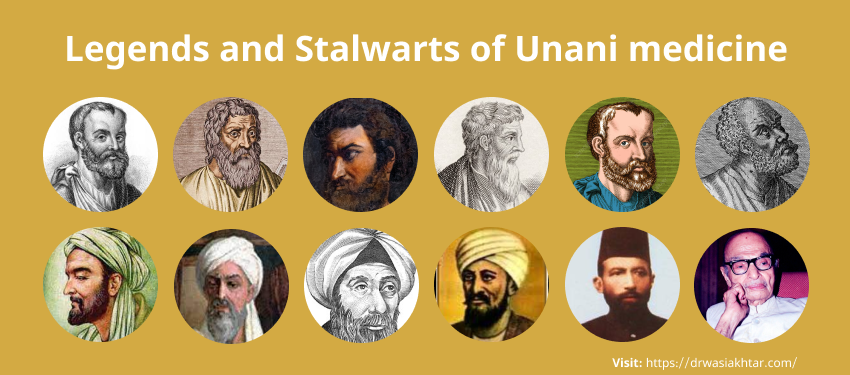What is Unani Medicine
Unani Medicine or Unani Tib is one of the traditional systems of medicine recognized by World Health Organization (WHO). The practitioners or doctors or the physicians of Unani system of medicine are widely recognized as HAKEEM, and hence some people mentioned this profession as HIKMAT. Unani system of medicine has its own Basic Principles, initially founded by Hippocrates (Buqrat) and has rich classical texts authored by Greek Physicians, Roman Physicians, Arab Physicians, Persian Physicians and Physicians of Indian subcontinent.
History of Unani Medicine
History of Unani medicine is as old as the history of medicine itself. Before the time of Hippocrates diseases were considered as curse/ a result of evil spirits, and treatment was done by exorcists/ magicians/ by Godman.
The Unani medicine has its Roots from Ancient Mesopotamian and Ancient Egyptian civilization. In the time of Mesopotamian civilization All the Physicians were Magician also and Spirituality was much dominant. KING HAMMURABI introduced Outcome based Fee structure for Medical Practitioners and he was the one who for the very first time postulated medical ethics and made Law for Medical practitioners, which was named as Hammurabi Code.
Ancient Egyptian Medicine produces the record of Earliest Herbal treatment, and plants were used as the primary means of treatment. During this period Egyptians emphasized the Surgery as one of the method of treatment. Imhotep regarded as being the World's first Physician was born in 3000 BC. It is believed that Imhotep composed the “Edwin Smith Papyrus” one of the oldest medical record. He founded a Medical School in Memphis, Egypt. These accomplished are what ultimately led to him being declared the God of medicine.
Greeks developed this system in an Organized Way.
Asclepius was a highly skilled Practical Doctor in the era of Ancient Greek. He is considered as the Greek God of Medicine, He was called as God by the patients. His Stick with Snake became the Symbol of Medical profession. The whole family of Asclepius (all Daughters and Sons) was dedicated to Health and Healing. Hygeia and Panacea were daughters of Asclepius, and due to their extraordinary contribution in health services they were declared as Goddess; Hygeia the goddess of cleanliness & sanitation, and Panacea the goddess of universal health.
It was Hippocrates (460 BC-370 BC) who introduced disease and treatment as Science and freed this noble profession from superstitions and disbelieves. Hippocrates disputed the theory of “ill spirits” and proved that there were “Real and Physical causes” behind illnesses. Hippocrates postulated the basic principles of Medicine, and introduced Humoural theory. In Greek literature around 60 treatises often attributed to Hippocrates. “Natural forces within us (طبیعت) are the true healers of disease” –Hippocrates
During the Medieval period Medicine flourished in Europe. First Medical University was established in 10th Century in Salerno (Italy) where Greek Manuscripts were studied and taught. University trained scholars were called “Physicians”, only serve the Wealthy people. Surgeons/ Barbers work under Physicians, and they perform bloodletting, teeth extraction, leech application, surgeries of hernia, gall bladder etc.
Byzantine Medicine, established by Byzantine Empire (Constantinople/ Istanbul, formerly Byzantium). Byzantine medicine drew largely on Greek & Roman medicine. They compiled and standardized the Medical knowledge into text books.
The legacy of medicine further Contributed and Translated by the Arabs and Transferred to various parts of the World. Arabs produced Legends like Abu al-Hasan Ali ibn Sahl Rabban al-Tabari (838 – 870 CE; 810–855 CE), Ali ibn al-'Abbas al-Majusi (died in 994 CE), Abū Bakr Muhammad bin Zakariyyā Rāzī (854–925 CE), Abū al-Qāsim Khalaf ibn al-'Abbās al-Zahrāwī (936-1013 AD), Abū ʿAlī al-Ḥusayn ibn ʿAbdillāh ibn al-Ḥasan ibn ʿAlī ibn Sīnā (Avicenna) (980 –1037) and Zayn al-Din Sayyed Isma‘il ibn Husayn Jurjani (1040–1136) and many more. These stalwarts enriched this system of medicine and brought it to such a level of acceptance that this system was followed by the Western world for a long.
Unani Medicine in India
Through Mughals this system of medicine reached India, and India itself produced many Hakeems who further nurtured it, thus it became a sister system to already existing system of medicine viz. Ayurveda. During the time of British rule, it became familiar as Unani medicine in Indian Subcontinent to differentiate it from the Ayurveda (which already existed there). It was the Academic honesty of the Muslim Physicians and Scholars of India that despite vast contributions of Arab, Persian and Indian, they acknowledged the original contributions and developments by the Greeks and named this system of medicine as Unani Medicine. And now it has been recognized by the WHO and practiced in various countries with this name.
Hakeem Muhammad Najmul Ghani Khan Rampuri was born in Rampur, Uttar Pradesh, India on October 7, 1859. He authored Khazainul Advia, with details of single drugs of Unani medicine.
Hakim Ajmal Khan (1863–1927 AD), a great visionary and freedom fighter, he established three important institutions viz. A&U Tibbia College, Hindustani Dawakhana and Ayurvedic Rasayanshala in Delhi. He is the Pioneer of Experimental Research in Unani medicine in India.
Hakeem Abdul Hameed (1908-1999 AD) Founder-Chancellor of Jamia Hamdard at New Delhi established Hamdard laboratories, Hamdard National Foundation and Hamdard Education Society.
- The Government of India facilitated the growth and development of Unani medicine by recognizing its utility and scope and integrated with Health Care Delivery system of India.
- Fortunately at present India is the country having largest infrastructure of Unani Medicine in the field of:
- Education: 50+ Colleges (Government as well as Private colleges) around the country established in almost all states ranging from Jammu & Kashmir to Tamil Nadu, Maharashtra to West Bengal. There are about 15+ Colleges having PG Departments where research is also conducted. Government of India established National Institute of Unani Medicine in Bengaluru, Karnataka, and another NIUM has already inaugurated in Ghaziabad. Some of the institutes are also producing Ph.D. in Unani medicine.
- Health Care Facility: World’s largest Health care facility of Unani medicine is present in India both in Public sector and in Government sector. There are many Unani Hospitals, Government Dispensaries and Clinical establishments.
- Research: Central Council for Research in Unani Medicine (CCRUM) with Headquarter in New Delhi has a National Research Institute of Unani Medicine for Skin Disorders (NRIUM SD), Many Regional Research Institute of Unani medicine (RRIUM), Regional Research Center, Clinical Research Unit and many research establishments throughout India.
Unani System of Medicine—Global Scenario
Unani Medicine is presently being practiced in many countries around the world that include Iran, Bangladesh, Pakistan, China, Sri Lanka, South Africa, UAE, Kuwait and other countries Institution of Unani Medicine is present in India, Bangladesh, Sri Lanka, South Africa and Pakistan.
India has emerged as a global leader in Unani Medicine with largest infrastructure of educational institutions, research organizations, and primary healthcare network. India has largest number of Unani Medicine Practitioners and largest number of Quality Unani drug manufacturing industries.



Write your Comment
Comment List
Nice article. It give us a great Knowledge